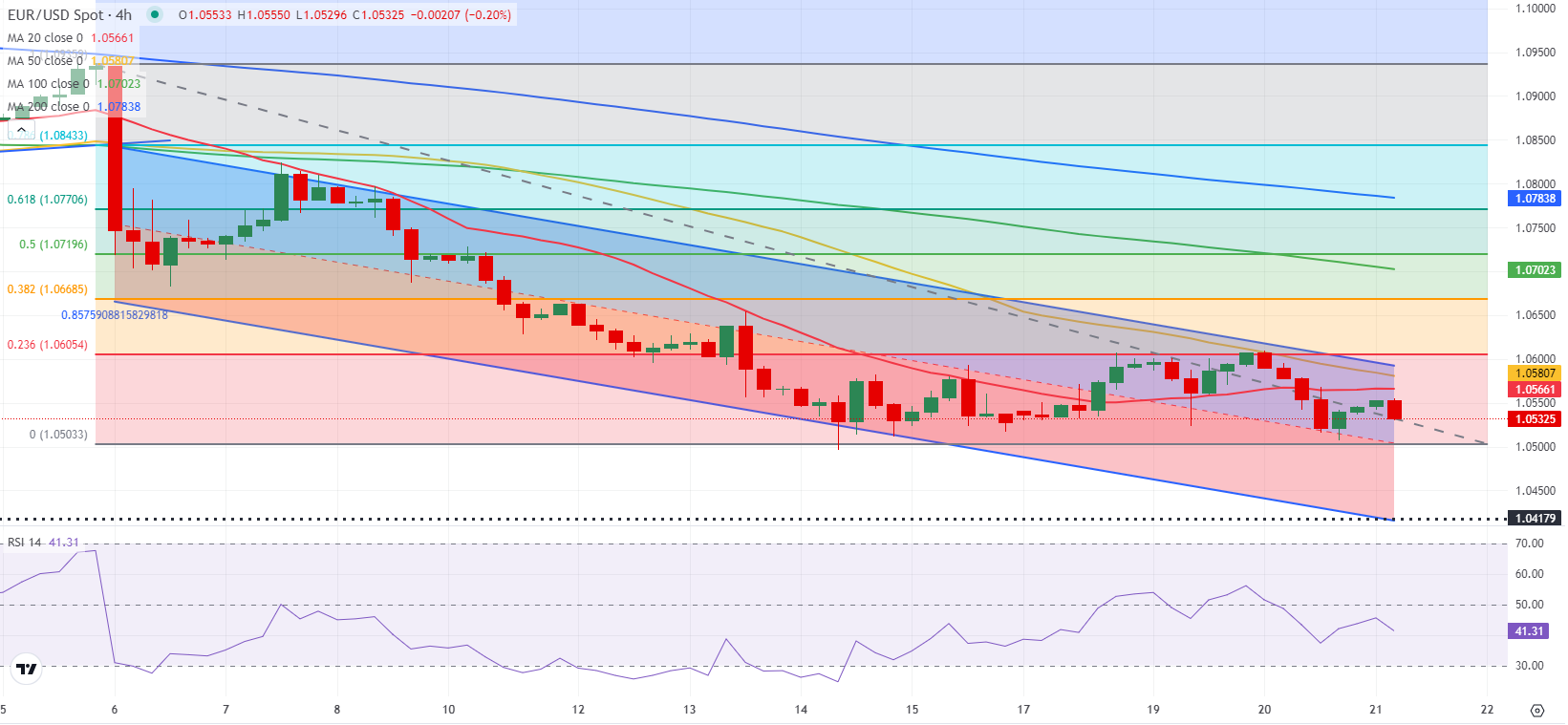- EUR/USD trades below 1.0550 after closing in the red on Wednesday.
- The technical outlook suggests that the bearish bias remains intact.
- Investors await mid-tier macroeconomic data releases from the US.
EUR/USD struggles to stage a rebound and trades below 1.0550 in the European morning on Thursday after closing in negative territory on Wednesday. The pair remains technically bearish in the near term as market participants await macroeconomic data releases from the US.
Euro PRICE This week
The table below shows the percentage change of Euro (EUR) against listed major currencies this week. Euro was the weakest against the Canadian Dollar.
| USD | EUR | GBP | JPY | CAD | AUD | NZD | CHF | |
|---|---|---|---|---|---|---|---|---|
| USD | 0.06% | -0.17% | 0.37% | -0.84% | -0.78% | 0.06% | -0.49% | |
| EUR | -0.06% | -0.07% | 0.44% | -0.79% | -0.69% | 0.11% | -0.44% | |
| GBP | 0.17% | 0.07% | 0.51% | -0.73% | -0.63% | 0.18% | -0.38% | |
| JPY | -0.37% | -0.44% | -0.51% | -1.25% | -1.11% | -0.29% | -0.82% | |
| CAD | 0.84% | 0.79% | 0.73% | 1.25% | 0.09% | 0.91% | 0.36% | |
| AUD | 0.78% | 0.69% | 0.63% | 1.11% | -0.09% | 0.81% | 0.26% | |
| NZD | -0.06% | -0.11% | -0.18% | 0.29% | -0.91% | -0.81% | -0.54% | |
| CHF | 0.49% | 0.44% | 0.38% | 0.82% | -0.36% | -0.26% | 0.54% |
The heat map shows percentage changes of major currencies against each other. The base currency is picked from the left column, while the quote currency is picked from the top row. For example, if you pick the Euro from the left column and move along the horizontal line to the US Dollar, the percentage change displayed in the box will represent EUR (base)/USD (quote).
The modest increase seen in the US Treasury bond yields and the cautious market stance helped the US Dollar (USD) stay resilient against its peers midweek, causing EUR/USD to stretch lower.
Early Thursday, European Central Bank (ECB) policymaker Francois Villeroy de Galhau said that the balance of risks to growth and inflation is shifting to the downside, adding that they should continue to reduce the degree of monetary policy restriction. These comments seem to be making it difficult for the Euro to attract investors.
Later in the day, the US Department of Labor will release the weekly Initial Jobless Claims data. Since reaching 260,000 in early October, the number of first-time applications declined steadily and marked its lowest print since April at 217,000 in the previous week. Markets expect Initial Jobless Claims to rise slightly to 220,000 in the week ending November 16. A reading close to 200,000 could provide a boost to the USD with the immediate reaction. On the other hand, an expected increase, with a print above 240,000, could hurt the currency and open the door for a rebound in EUR/USD.
The US economic calendar will also feature Existing Home Sales data for October and regional manufacturing surveys for November from the Federal Reserve (Fed) Bank of Philadelphia and Kansas City.
EUR/USD Technical Analysis
The Relative Strength Index (RSI) indicator on the 4-hour chart started to edge lower after rising toward 50, highlighting buyers' hesitancy. On the downside, 1.0500 (static level, mid-point of the descending regression channel) aligns as key support before 1.0450 (static level) and 1.0420 (lower limit of the descending channel).
If EUR/USD manages to rise above 1.0600-1.0590 (Fibonacci 23.6% retracement of the latest downtrend, upper limit of the descending channel) and stabilize there, technical buyers could show interest. In this scenario, 1.0670 (Fibonacci 38.2% retracement) could be seen as next resistance.
Euro FAQs
The Euro is the currency for the 19 European Union countries that belong to the Eurozone. It is the second most heavily traded currency in the world behind the US Dollar. In 2022, it accounted for 31% of all foreign exchange transactions, with an average daily turnover of over $2.2 trillion a day. EUR/USD is the most heavily traded currency pair in the world, accounting for an estimated 30% off all transactions, followed by EUR/JPY (4%), EUR/GBP (3%) and EUR/AUD (2%).
The European Central Bank (ECB) in Frankfurt, Germany, is the reserve bank for the Eurozone. The ECB sets interest rates and manages monetary policy. The ECB’s primary mandate is to maintain price stability, which means either controlling inflation or stimulating growth. Its primary tool is the raising or lowering of interest rates. Relatively high interest rates – or the expectation of higher rates – will usually benefit the Euro and vice versa. The ECB Governing Council makes monetary policy decisions at meetings held eight times a year. Decisions are made by heads of the Eurozone national banks and six permanent members, including the President of the ECB, Christine Lagarde.
Eurozone inflation data, measured by the Harmonized Index of Consumer Prices (HICP), is an important econometric for the Euro. If inflation rises more than expected, especially if above the ECB’s 2% target, it obliges the ECB to raise interest rates to bring it back under control. Relatively high interest rates compared to its counterparts will usually benefit the Euro, as it makes the region more attractive as a place for global investors to park their money.
Data releases gauge the health of the economy and can impact on the Euro. Indicators such as GDP, Manufacturing and Services PMIs, employment, and consumer sentiment surveys can all influence the direction of the single currency. A strong economy is good for the Euro. Not only does it attract more foreign investment but it may encourage the ECB to put up interest rates, which will directly strengthen the Euro. Otherwise, if economic data is weak, the Euro is likely to fall. Economic data for the four largest economies in the euro area (Germany, France, Italy and Spain) are especially significant, as they account for 75% of the Eurozone’s economy.
Another significant data release for the Euro is the Trade Balance. This indicator measures the difference between what a country earns from its exports and what it spends on imports over a given period. If a country produces highly sought after exports then its currency will gain in value purely from the extra demand created from foreign buyers seeking to purchase these goods. Therefore, a positive net Trade Balance strengthens a currency and vice versa for a negative balance.
Information on these pages contains forward-looking statements that involve risks and uncertainties. Markets and instruments profiled on this page are for informational purposes only and should not in any way come across as a recommendation to buy or sell in these assets. You should do your own thorough research before making any investment decisions. FXStreet does not in any way guarantee that this information is free from mistakes, errors, or material misstatements. It also does not guarantee that this information is of a timely nature. Investing in Open Markets involves a great deal of risk, including the loss of all or a portion of your investment, as well as emotional distress. All risks, losses and costs associated with investing, including total loss of principal, are your responsibility. The views and opinions expressed in this article are those of the authors and do not necessarily reflect the official policy or position of FXStreet nor its advertisers. The author will not be held responsible for information that is found at the end of links posted on this page.
If not otherwise explicitly mentioned in the body of the article, at the time of writing, the author has no position in any stock mentioned in this article and no business relationship with any company mentioned. The author has not received compensation for writing this article, other than from FXStreet.
FXStreet and the author do not provide personalized recommendations. The author makes no representations as to the accuracy, completeness, or suitability of this information. FXStreet and the author will not be liable for any errors, omissions or any losses, injuries or damages arising from this information and its display or use. Errors and omissions excepted.
The author and FXStreet are not registered investment advisors and nothing in this article is intended to be investment advice.
Recommended Content
Editors’ Picks

EUR/USD falls toward 1.0500 amid risk-off mood
EUR/USD has come under fresh selling pressure, easing toward 1.0500 in the European session on Thursday. The pair faces headwinds from risk-off flows due to rising geopolitical conflict between Russia and Ukraine and worries over the potential US tariffs on the EU. ECB- and Fedspeak are awaited.

GBP/USD stays pressured toward 1.2600 ahead of US data, Fedspeak
GBP/USD remains pressured toward 1.2600 in European trading on Thursday. The pair's underperformance could be attributed to a risk-aversion market environment. Traders stay cautious amid rife geopolitical tensions ahead of mid-tier US data and Fedspeak.

Gold price extends gains beyond $2,650 amid rising geopolitical risks
Gold price extends its bullish momentum further above $2,650 in Thursday's European session. Gold price risies for the fourth straight day, sponsored by geopolitical risks stemming from the worsening Russia-Ukraine war. US data and Fedspeak are next in focus.

Shiba Inu holders withdraw 1.67 trillion SHIB tokens from exchange
Shiba Inu (SHIB) trades slightly higher, around $0.000024, on Thursday after declining more than 5% the previous week. SHIB’s on-chain metrics project a bullish outlook as holders accumulate recent dips, and dormant wallets are on the move, all pointing to a recovery in the cards.

Why Nvidia’s story is far from over
Nvidia delivers another earnings beat: Nvidia exceeded expectations with $35.08 billion in revenue, a 94% year-over-year increase, driven by strong performance in its data center business, which more than doubled to $30.8 billion.

Best Forex Brokers with Low Spreads
VERIFIED Low spreads are crucial for reducing trading costs. Explore top Forex brokers offering competitive spreads and high leverage. Compare options for EUR/USD, GBP/USD, USD/JPY, and Gold.
